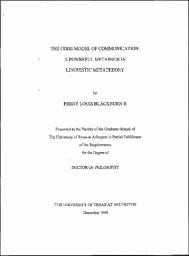
ATTENTION: The works hosted here are being migrated to a new repository that will consolidate resources, improve discoverability, and better show UTA's research impact on the global community. We will update authors as the migration progresses. Please see MavMatrix for more information.
Show simple item record
| dc.contributor.author | Blackburn II, Perry Louis | |
| dc.date.accessioned | 2020-10-12T14:35:19Z | |
| dc.date.available | 2020-10-12T14:35:19Z | |
| dc.date.issued | 1999-12 | |
| dc.identifier.uri | http://hdl.handle.net/10106/29510 | |
| dc.description.abstract | The concept of communication is a fundamental notion in the metatheory of linguistics. This study explores the historical development and influence of a particular model of communication, labeled the ‘code model’. This model characterizes communication as a process wherein a source (encoder) conveys a message to a receiver (decoder) through the transmission of a signal. Communication is considered successful if the message received is the same as that sent. This study reviews use of the code model in various linguistic publications, analyzing the code model as a conceptual metaphor and arguing that it structures the way linguists think about communication and language. While some suggest that the code model predates even Aristotle, this analysis shows that it is better understood as a contemporary integration of three models which come from disparate sources: (1) the conduit metaphor (a folk model of communication), (2) Saussure's speech circuit (the model of communication expounded in Saussure's Cours de linguistique générale, and (3) modern information theory (a model and theory of communication from electrical engineering that has provided essential terminology for the code model account of communication). By integrating these three models, linguists have created and maintained several anomalies, which inherently weaken the code model account of communication. Some have argued that the discipline of linguistics is not united under a single paradigm. This study argues that the discipline is indeed united under a grand tradition, which may be labeled the Saussurean paradigm. While various contemporary traditions within the Saussurean paradigm differ in how they supply details for the model and in their rules for its application, they are nevertheless united in dependence upon code model presuppositions. Recently, however, several traditions have abandoned the model and begun developing alternative views of communication. As a means of highlighting the power that the code model wields as a conceptual metaphor, an alternative model of communication is suggested and contrasted with the code model. Based upon an artist-and-artifact metaphor, this alternative model is not proposed as an ultimate replacement for the code model, but as an antithesis—an essential element in the evaluation and evolution of linguistic metatheory. | en_US |
| dc.language.iso | en_US | en_US |
| dc.publisher | University of Texas at Arlington | en_US |
| dc.subject | Social sciences | en_US |
| dc.subject | Language | en_US |
| dc.subject | Literature and linguistics | en_US |
| dc.subject | Code model | en_US |
| dc.subject | Communication | en_US |
| dc.subject | Linguistic metatheory | en_US |
| dc.subject | Metaphor | en_US |
| dc.title | THE CODE MODEL OF COMMUNICATION: A POWERFUL METAPHOR IN LINGUISTIC METATHEORY | en_US |
| dc.type | Dissertation | en_US |
| thesis.degree.department | Humanities | |
| thesis.degree.name | Doctor of Philosophy in Humanities | |
Files in this item
- Name:
- The Code Model of Communication.pdf
- Size:
- 20.03Mb
- Format:
- PDF
- Description:
- PDF
This item appears in the following Collection(s)
Show simple item record


